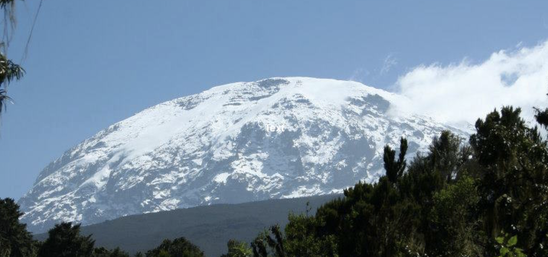|
by Ylenia Vimercati Mount Kilimanjaro, the tallest free-standing mountain on Earth located on the Kenya-Tanzania border, is well known for its collapsed summit forming the Reusch crater, and its permanent plateau glaciers. But, is this “island of the cryosphere” going to last long? In recent years Mt. Kilimanjaro has become an “icon” of climate change due to its dramatic ice loss that has attracted much attention among scientists, especially microbiologists, who are concerned about the fate of biological communities surviving in this harsh environment. Mt. Kilimanjaro seems to be of interest to astrobiologists too for its extreme environmental conditions considered as potential analogues for habitable zones on Mars. 85% of the ice cover has already disappeared and an increase of incoming radiation and a severe drop in atmospheric moisture are posing a threat to Mt. Kilimanjaro glaciers and their unique microbial community that may be lost forever along with the stored information on climatic and environmental changes through time. Up to now there have been no investigations published on the high-elevation microbial diversity of the habitats at the top of Mt. Kilimanjaro and on how these communities are responding to climate change drivers. This makes it extremely important and urgent to study the microbiology of the glaciers at the top of the mountain. A cutting-edge study published in July in Scientific Reports led by the AMO’s Lara Vimercati describes the diversity of soil and ice-dwelling microbes near the summit of Mt. Kilimanjaro. Field collections took place in 2012 at the border of the tabular-shaped plateau glacier in the Southern Icefield at 5772 m elevation. Surprisingly, ice and periglacial soils contain rich and diverse assemblages of Bacteria and Eukarya, probably indicating high rates of dispersal to the top of the mountain and/or that the habitat is more conducive to microbial life than previously expected. As for Bacteria, richness was high for both soil and ice communities and the high diversity encountered in the samples can be explained by glaciers supporting active microbes that gain nutrients from the atmosphere. According to the study, aeolian transportation seems crucial in the assembly of bacterial communities on Mt. Kilimanjaro. Results from the community composition analysis revealed that bacteria from soil and ice were dominated by Betaproteobacteria, especially members of the Comamonadaceae family. Scientists classified bacterial taxa into “endemic” (meaning only found on Mt. Kilimanjaro) and “non-endemic” (meaning also found elsewhere) and found that most bacterial communities within the second category were cosmopolitan. Within the Bacteria the dominant Polaromonas clade was selected to test its biogeographical distribution and analysis revealed that spatial structuring was not evident, supporting the contention that Polaromonas phylotypes are globally distributed within all glacial habitats. According to the study these Betaproteobacteria may use multiple aeolian deposited carbon sources making wind transportation fundamental for the assembly of bacterial communities. It is still unclear whether Polaromonas are indigenous to ice or they are transients from the upper atmosphere; they may be being constantly deposited in glacial systems, but not necessarily growing there.
As for Eukarya, phylogenetic analysis showed that ice communities were dominated by Cercozoa, while in soil they were the most abundant taxonomic group together with Chlorophyta. Within the Cercozoa, the authors observed that most sequences fell within the Trinematidae and the Vampirellida orders. Sequencing analysis of Vampirellida revealed that they are different from any other taxa in Genbank suggesting that this is a unique Vampirellida community with a high endemicity on Mt. Kilimanjaro probably associated with the fumarolic activity of the summit. Observations showed that they were more abundant in ice samples compared to soil samples indicating that the Vampirellida may have come from the ice. Testate amoebae abundance within the Cercozoa was high and it is probably sustained by feeding on fungi, algae and bacteria. This study is a first step towards gaining information on the global dispersal of microbes at high elevation sites in Africa. Despite the isolation of Mt. Kilimanjaro from any other mountain, the summit represents an oasis where microbes in the upper atmosphere thrive. Microbes can disperse over long distances, but they require specific adaptations to survive in high-elevation icy environments. The authors state that more work is needed to determine if these organisms can actually grow on Mt. Kilimanjaro or if they are just transient wind-dispersed microorganisms. Microbial diversity was higher than expected compared to other high volcanoes in drier regions. Bacterial community richness and diversity was quite high, and the presence of cosmopolitan bacteria suggests that the effect of distance is overwhelmed by continuous aeolian dispersal. As Mt. Kilimanjaro’s icecaps continue to vanish undisturbed, understanding the biodiversity and function of the organisms that live in the glacial and periglacial soils of the summit is extremely important and requires our attention. These ecosystems may soon disappear along with its biodiversity and pool of genes adapted to these extreme environments. The study of these life forms may also provide us a model for viable habitats for life on Mars where similar conditions may have existed or still exist. References: Vimercati L, Darcy JL, Schmidt SK (2019) The disappearing periglacial ecosystem atop Mt. Kilimanjaro supports both cosmopolitan and endemic microbial communities. Scientific Reports 9:10676
0 Comments
Leave a Reply. |
AuthorVarious lab members contribute to the MoM Blog Archives
October 2023
Categories |


 RSS Feed
RSS Feed
